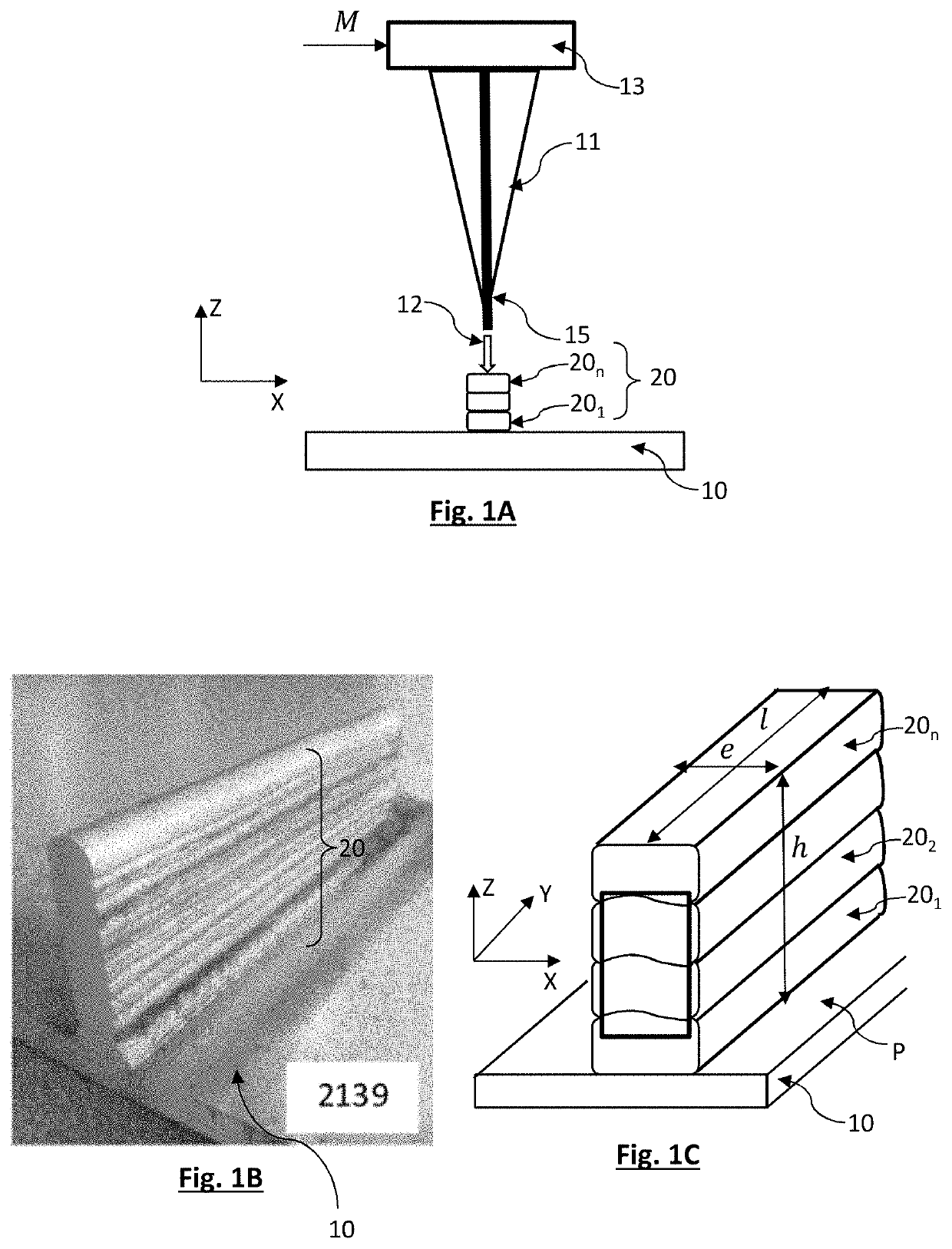Process for manufacturing an aluminum alloy part
- Summary
- Abstract
- Description
- Claims
- Application Information
AI Technical Summary
Benefits of technology
Problems solved by technology
Method used
Image
Examples
example 1
[0092]A plurality of filler wires 15 were used in order to manufacture different walls:[0093]alloy 2319 wires corresponding to industrial welding wires;[0094]alloy 2219 and 2139 wires obtained from cast prototype alloys, the wires being obtained by extrusion and wire drawing from billets having a diameter of 55 mm and a length of 150 mm.
[0095]In this example, the filler wire had a diameter of 1.2 mm. An inert gas welding power source available under the reference FK 4000-RFC by Fronius and a Motoman MA210 welding robot by Yaskawa were used.
[0096]The walls had a thickness e in the range 4 mm to 6 mm. The walls had a length l of 10 cm and a height h of 3 cm.
[0097]The parameters for the implementation of the WAAM method were as follows:[0098]torch travel speed: 42 cm / min;[0099]wire feed rate: in the range 5 to 9 m / min;[0100]test conducted at atmospheric pressure.
[0101]The chemical composition of the walls was measured by mass spectrometry of ICP-OES type (inductively coupled plasma—opt...
example 2
[0123]Another series of tests was conducted using a filler material formed by a 2295 alloy. Walls 20 similar to those described hereinabove were produced again by implementing a WAAM method at atmospheric pressure. The chemical composition, in terms of weight percentage, of each wall was as follows:
TABLE 2LiSiFeCuMnMgTiAgVZr1.080.020.044.530.340.180.020.230.15
[0124]Measurements performed on the filler wire did not reveal any significant deviations between the composition of the filler wire and the walls formed therefrom.
[0125]The walls 20 then underwent T6 treatment or T6 treatment preceded by a hot isostatic compression (HIP) step. During the T6 treatment, solution heat treatment was carried out for 2 h at a temperature of 529° C. and aging was carried out for 100 h at a temperature of 160° C.
[0126]FIG. 2F shows the Vickers Hardness HV 0.1 values for the walls 20 obtained by implementing different alloys, these measurements having been performed according to standard NF EN ISO 6507...
example 3
[0137]In this example, walls were produced by the SLM method described hereinabove. In the following tests, the laser source 31 is a Nd / Yag laser with a power of 400 MW.
[0138]Cubic parallelepipeds of dimensions 1 cm×1 cm×1 cm were formed according to this method, by stacking different layers formed, the powder 25 being obtained from aluminium alloy 2139.
[0139]The composition of the powder was determined by ICP-OES and is given as a weight percentage in the following table.
TABLE 3SiFeCuMnMgTiAgVZr0.040.094.80.290.390.050.34
[0140]A particle size analysis was conducted according to standard ISO 1332 using a Malvern 2000 particle size analyser. The curve describing the evolution in the volume fraction as a function of the diameter of the particles forming the powder describes a distribution similar to a Gaussian distribution. If d10, d50 and d90 respectively represent the fractiles at 10%, at 50% (median) and at 90% of the distribution obtained, a rate of uniformity
σ=d90-d10d50
and a sta...
PUM
| Property | Measurement | Unit |
|---|---|---|
| Fraction | aaaaa | aaaaa |
| Fraction | aaaaa | aaaaa |
| Fraction | aaaaa | aaaaa |
Abstract
Description
Claims
Application Information
 Login to View More
Login to View More - R&D
- Intellectual Property
- Life Sciences
- Materials
- Tech Scout
- Unparalleled Data Quality
- Higher Quality Content
- 60% Fewer Hallucinations
Browse by: Latest US Patents, China's latest patents, Technical Efficacy Thesaurus, Application Domain, Technology Topic, Popular Technical Reports.
© 2025 PatSnap. All rights reserved.Legal|Privacy policy|Modern Slavery Act Transparency Statement|Sitemap|About US| Contact US: help@patsnap.com



